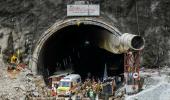'The rocks, the geology of the Himalayas will always spring surprises.'
'It's basically force majeure and the will of god.'

"We cannot stay without constructing these tunnels. We cannot leave these areas not connected with the rest of the nation," Colonel Dipak Patil, who was in charge of the incredible, 17-day long Silkyara tunnel rescue operation, tells Prasanna D Zore/Rediff.com in the concluding segment of a two-part interview.
- Part 1 of the Interview: 'Trapped workers played cricket'
Tell us about the fragile geology of these hills...
In the entire Himalayas, you'll find these kinds of zones. They're called sheared zones and these zones are very unstable. They are very difficult for tunneling. But that doesn't mean that we should stop tunneling in these areas.
The beauty of tunnels is that it reduces distance, it reduces accidents. In the overall perspective, tunneling reduces the carbon footing. It helps the environment because the distance is reduced.
And if you're not entering the pristine forest, then you are actually saving planet Earth. So tunneling is the most important facet, and we have to do it by whatever means which are safe.
We have now started doing tunneling in the Himalayas, and we will find ways and means and methods of formulating a better contract, getting new technologies. It's inevitable. We cannot stay without constructing these tunnels.
We cannot leave these areas not connected with the rest of the nation.
Now there are so many tunnels, so many holes being drilled into this particular mountain hill at Silkyara. Do you think it will continue to retain its stability?
Would the Silkyara tunnel, when it is constructed, will it be safe for people to travel through this tunnel?
The rock will continue to retain its stability. There's no problem as such. Holes which have been dug, will all be filled up. There's no problem as such.

A lot of questions are being raised about the safety protocols not being followed. There were no Hume pipes. There were no safety tunnels that are usually constructed...
We had used Hume pipes, and we earlier had about 21 collapses. Not exactly collapses. There were cavities.
Whenever you're doing tunneling, all across the world, we will always find cavities near the face of the heading. But then the problem is that each cavity that we encountered were not more than 15 metres, 7 metres, 10 metres, 3 metres, something like that, in the linear length.
This was the first time it was 60 metres (which led to the trapping of workers inside the tunnel from November 12 to 28).
And in those cavities, whatever we had learned, we used to put Hume pipes. But in this portion, we were confident that nothing will happen. The readings, the instruments did not show us any deformations. So we were confident nothing is going to happen here.
The rocks, the geology of the Himalayas will always spring surprises.
It was inevitable, and nobody could stop it. It's basically force majeure and the will of god.
There are many experts citing the use of dynamites to blast the rocks inside and not using tunnel boring machines as the reason why the tunnel caved in...
TBMs don't work in these kinds of fragile mountains. TBMs basically work in a homogeneous kind of rock strata.
If you start using TBMs here, it generally gets stuck. Even double-shield TBMs get stuck. So drilling and blasting in the NATM method -- the New Austrian Tunneling Method -- is the only method by which we can successfully do tunneling in the Himalayas.
There is a lot of criticism about there being no safety tunnels being constructed along the main tunnel which could have helped ensure better safety of workers during such tunnel collapses...
Generally, any tunnel which is 1700 metres and beyond is generally a twin-tube tunnel.
This is a learning for us, of course, that we should always go with two tunnels which are parallel to each other, with lateral connectivity, which helps in the rescue ops (in the event one of the two tunnels collapse). This is a lesson. Yes, we are graduating into it.
Even Europe always had single tube tunnels till the 1990s, when they had an accident in which 200-300 workers were killed. They died because of fire. There was some car accident inside some tunnel. Thereafter, they graduated and they started having twin tube tunnels.
These kinds of tunnel disasters all across the world are quite common. But, yes, the size of this particular collapse was big and the number of days that they were stuck was large.
And, yes, the degree of efforts which were taken was also colossal. But the thought that we will never ever be successful never crossed our minds.
Success was 100 per cent sure -- by this mean or that mean or the other mean.
We had multiple plans, and at least one of the plans was bound to succeed.

Is this the only major lesson learned from this mishap?
What are the other major lessons which can be carried forward to avoid such mishaps for next tunnel that will be constructed in this terrain?
Other major lesson is that we should go for alignments of tunnels through little better strata. We should avoid strata which are very fragile. We should go for strata even if they are longer, if they are sturdier, we should go for those longer distance alignments.
What next for you, Colonel Patil?
I was repatriated back to the Indian Army. Yes, I'm again sent back (to the NHIDCL). I've volunteered for it, and that is how I come back. They (Army Headquarters) have taken my opinion, and thereafter they have given me the extension.
I wish to complete this challenging project. It is one of the most difficult projects in the Himalayas because of the large diameter of the tunnel and because of the fragile geology through which it is going.
I'll stay with them (NHIDCL) for another year and continue to offer my duties and my expertise in this field. I will continue to perform.
What do you think about the rat hole miners?
They've done a commendable job. There's no question about that.
For centuries, this kind of thing has been done by us humans. You will remember a lot of our forts, our palaces used to have small tunnels dug beneath them. This is the same technology.
Did you meet the trapped workers? What was their first reaction when they stepped out of those pipes?
Yes, of course. I met them later on. They needed to be taken to medical care and they had to be taken away from this place.
They were happy seeing so many people. A little surprised that it's not 15-20 people, but it's more than 200-300 people who have come to see them and look at them and also ask about their conditions and take care of.










